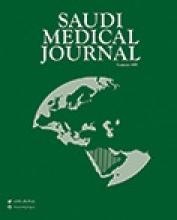Abstract
OBJECTIVE: To determine the prevalence of Helicobacter pylori (H. pylori) infection among patients presenting with peptic ulcer disease (PUD) and to establish the relationship between H. pylori infection and its diverse pathology. Secondly, we aimed to examine the effect of age, gender, and geographical distribution on the prevalence of the disease.
METHODS: The study included patients with PUD who underwent upper gastrointestinal endoscopy at Hera General Hospital, Makkah, Kingdom of Saudi Arabia between January 2003 and February 2004. We tested the biopsies for the detection of H. pylori by Campylobacter like organism (CLOTM) test, histopathology, immunoglobulin G (IgG) antibodies, culture, and antimicrobial susceptibility testing.
RESULTS: The overall prevalence rate of H. pylori infection among 132 patients with PUD was 63%, while it was high among females (70%) as compared with males (58%). The H. pylori were mainly found in chronic active gastritis (89%) and severe active gastritis (96%). Helicobacter pylori were documented by CLOTM test in 73 (55.3%) cases, histopathology in 69 (52.3%) cases, microbiological culture in 59 (44.7%) cases, and IgG antibodies in 61 (46.2%) cases. The highest resistance (31%) was found in metronidazole, while lowest the (3%) in tetracycline and erythromycin.
CONCLUSION: The highest prevalence of H. pylori was found in the younger age group with female preponderance. The leading causes of multifocal pathology were chronic and severe active gastritis secondary to H. pylori infection.
- Copyright: © Saudi Medical Journal
This is an open-access article distributed under the terms of the Creative Commons Attribution-Noncommercial-Share Alike 3.0 Unported, which permits unrestricted use, distribution, and reproduction in any medium, provided the original work is properly cited.






